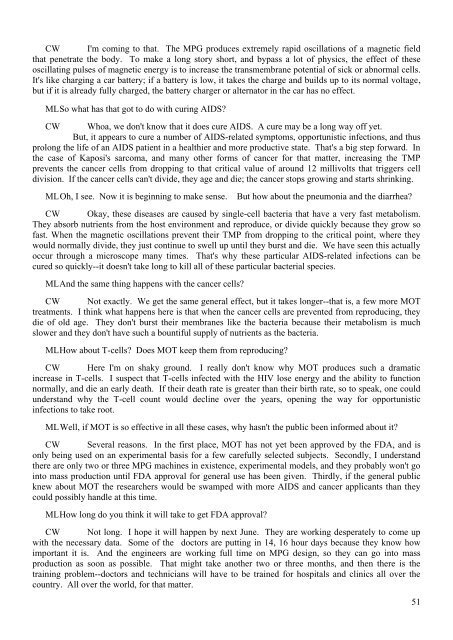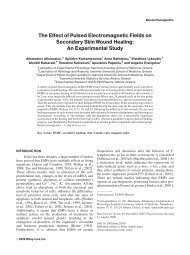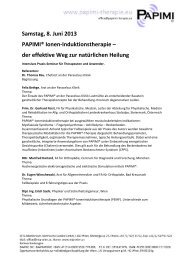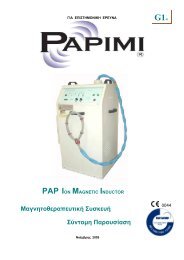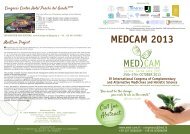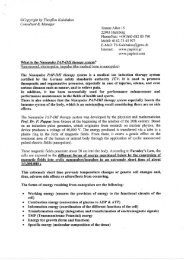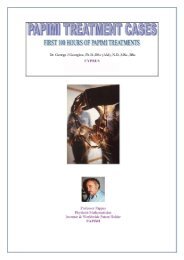Cases from private practices - Papimi
Cases from private practices - Papimi
Cases from private practices - Papimi
Create successful ePaper yourself
Turn your PDF publications into a flip-book with our unique Google optimized e-Paper software.
CW I'm coming to that. The MPG produces extremely rapid oscillations of a magnetic field<br />
that penetrate the body. To make a long story short, and bypass a lot of physics, the effect of these<br />
oscillating pulses of magnetic energy is to increase the transmembrane potential of sick or abnormal cells.<br />
It's like charging a car battery; if a battery is low, it takes the charge and builds up to its normal voltage,<br />
but if it is already fully charged, the battery charger or alternator in the car has no effect.<br />
ML So what has that got to do with curing AIDS<br />
CW Whoa, we don't know that it does cure AIDS. A cure may be a long way off yet.<br />
But, it appears to cure a number of AIDS-related symptoms, opportunistic infections, and thus<br />
prolong the life of an AIDS patient in a healthier and more productive state. That's a big step forward. In<br />
the case of Kaposi's sarcoma, and many other forms of cancer for that matter, increasing the TMP<br />
prevents the cancer cells <strong>from</strong> dropping to that critical value of around 12 millivolts that triggers cell<br />
division. If the cancer cells can't divide, they age and die; the cancer stops growing and starts shrinking.<br />
ML Oh, I see. Now it is beginning to make sense.<br />
But how about the pneumonia and the diarrhea<br />
CW Okay, these diseases are caused by single-cell bacteria that have a very fast metabolism.<br />
They absorb nutrients <strong>from</strong> the host environment and reproduce, or divide quickly because they grow so<br />
fast. When the magnetic oscillations prevent their TMP <strong>from</strong> dropping to the critical point, where they<br />
would normally divide, they just continue to swell up until they burst and die. We have seen this actually<br />
occur through a microscope many times. That's why these particular AIDS-related infections can be<br />
cured so quickly--it doesn't take long to kill all of these particular bacterial species.<br />
ML And the same thing happens with the cancer cells<br />
CW Not exactly. We get the same general effect, but it takes longer--that is, a few more MOT<br />
treatments. I think what happens here is that when the cancer cells are prevented <strong>from</strong> reproducing, they<br />
die of old age. They don't burst their membranes like the bacteria because their metabolism is much<br />
slower and they don't have such a bountiful supply of nutrients as the bacteria.<br />
ML How about T-cells Does MOT keep them <strong>from</strong> reproducing<br />
CW Here I'm on shaky ground. I really don't know why MOT produces such a dramatic<br />
increase in T-cells. I suspect that T-cells infected with the HIV lose energy and the ability to function<br />
normally, and die an early death. If their death rate is greater than their birth rate, so to speak, one could<br />
understand why the T-cell count would decline over the years, opening the way for opportunistic<br />
infections to take root.<br />
ML Well, if MOT is so effective in all these cases, why hasn't the public been informed about it<br />
CW Several reasons. In the first place, MOT has not yet been approved by the FDA, and is<br />
only being used on an experimental basis for a few carefully selected subjects. Secondly, I understand<br />
there are only two or three MPG machines in existence, experimental models, and they probably won't go<br />
into mass production until FDA approval for general use has been given. Thirdly, if the general public<br />
knew about MOT the researchers would be swamped with more AIDS and cancer applicants than they<br />
could possibly handle at this time.<br />
ML How long do you think it will take to get FDA approval<br />
CW Not long. I hope it will happen by next June. They are working desperately to come up<br />
with the necessary data. Some of the doctors are putting in 14, 16 hour days because they know how<br />
important it is. And the engineers are working full time on MPG design, so they can go into mass<br />
production as soon as possible. That might take another two or three months, and then there is the<br />
training problem--doctors and technicians will have to be trained for hospitals and clinics all over the<br />
country. All over the world, for that matter.<br />
51


